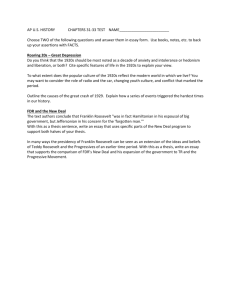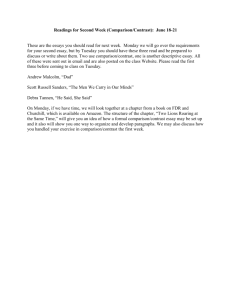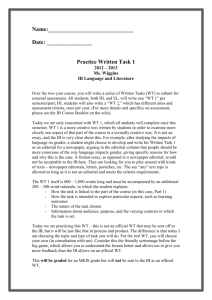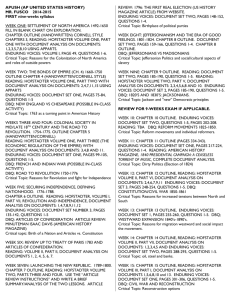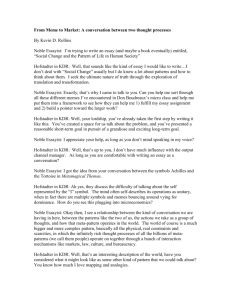FDR Essay Guidelines
advertisement
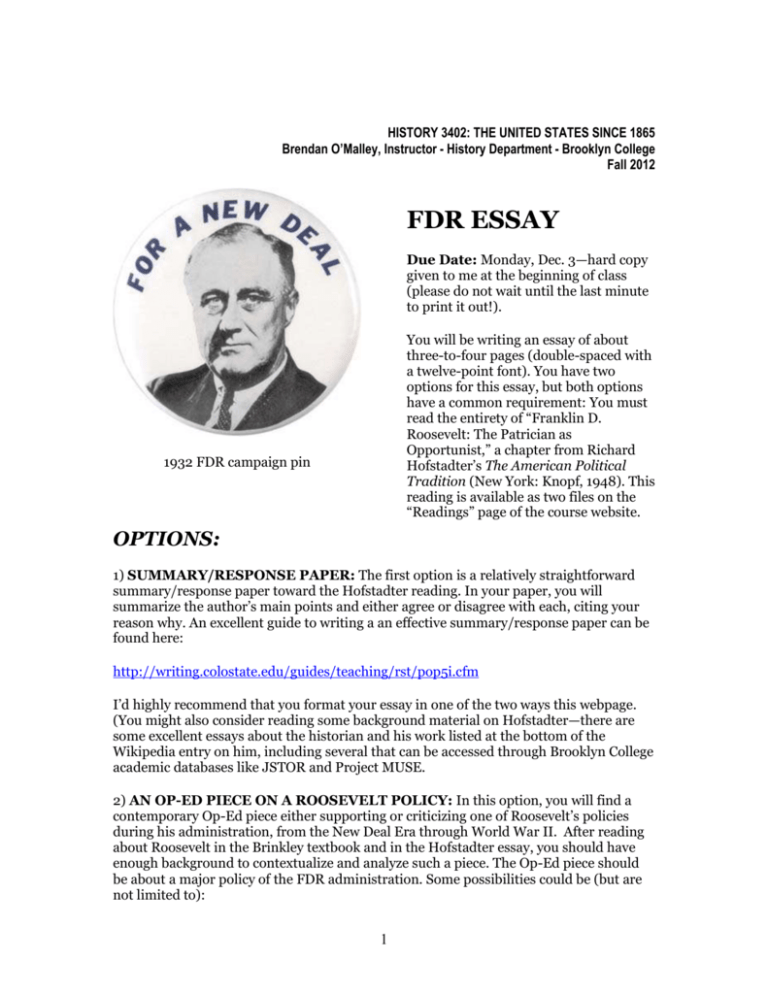
HISTORY 3402: THE UNITED STATES SINCE 1865 Brendan O’Malley, Instructor - History Department - Brooklyn College Fall 2012 FDR ESSAY Due Date: Monday, Dec. 3—hard copy given to me at the beginning of class (please do not wait until the last minute to print it out!). You will be writing an essay of about three-to-four pages (double-spaced with a twelve-point font). You have two options for this essay, but both options have a common requirement: You must read the entirety of “Franklin D. Roosevelt: The Patrician as Opportunist,” a chapter from Richard Hofstadter’s The American Political Tradition (New York: Knopf, 1948). This reading is available as two files on the “Readings” page of the course website. 1932 FDR campaign pin OPTIONS: 1) SUMMARY/RESPONSE PAPER: The first option is a relatively straightforward summary/response paper toward the Hofstadter reading. In your paper, you will summarize the author’s main points and either agree or disagree with each, citing your reason why. An excellent guide to writing a an effective summary/response paper can be found here: http://writing.colostate.edu/guides/teaching/rst/pop5i.cfm I’d highly recommend that you format your essay in one of the two ways this webpage. (You might also consider reading some background material on Hofstadter—there are some excellent essays about the historian and his work listed at the bottom of the Wikipedia entry on him, including several that can be accessed through Brooklyn College academic databases like JSTOR and Project MUSE. 2) AN OP-ED PIECE ON A ROOSEVELT POLICY: In this option, you will find a contemporary Op-Ed piece either supporting or criticizing one of Roosevelt’s policies during his administration, from the New Deal Era through World War II. After reading about Roosevelt in the Brinkley textbook and in the Hofstadter essay, you should have enough background to contextualize and analyze such a piece. The Op-Ed piece should be about a major policy of the FDR administration. Some possibilities could be (but are not limited to): 1 Emergency Banking Act (Mar. 1933) Social Security Act (passed Aug. 1935) 1937 Judicial Procedures Reform Bill (“Court-Packing Plan”) Executive Order 9066: Japanese Internment (Feb. 1942) FINDING AN OP-ED PIECE: Find an opinion or editorial piece published around the time of the enactment of the policy you have chosen. Please note that an opinion or editorial is different from a straightforward reporting of the news. An editorial expresses the opinion of the newspaper’s editors (and thus has no byline), while an opinion piece conveys the opinion of an attributed individual or group of authors. If you are having trouble distinguishing between an op/ed and regular newspaper piece, than please consult with the instructor before making your final choice. There are several historical newspaper databases that you might use that are available through the Brooklyn College Library database page, which you can find here: http://library.brooklyn.cuny.edu/resources/?view=databases For most of these, you will need your Brooklyn College email log-in to access them off campus. Some of the newspaper and magazines I’d suggest looking at are as follows: Nation Archive – The Nation is a progressive magazine that is still published today. New Republic Archive – The New Republic is a center/liberal magazine that is still published as well. New York Times Historical Edition – I know a lot of you will use this as it is the easiest, so those who go out of there way to use something different might get a small grade boost! NewspaperArchive.com – Gives access to smaller, local newspapers across the U.S. (I don’t like the interface, though). It will be best to enter time parameters you to narrow your search. For example, with the “Court-Packing Plan,” the bill was being discussed from January through March 1937, so it would be best to narrow your search to those initial months. Note: Unfortunately the “America’s Historical Newspapers” and “Early American Newspaper” databases only goes up to 1920, the New York Tribune ends in 1922, and the old Brooklyn Eagle database only goes to 1902. The “Popular Magazines” database starts in 1980, and the Wall Street Journal database only begins in 1984. None of these databases can be used. PART TWO: THE ESSAY After picking your piece, begin to formulate an idea for a brief essay--no more than about four or five double-spaced pages—which will have three parts: 1) SUMMARY/CONTEXT: In this section, you will summarize what the op/ed is saying, and also provide any relevant context that might help us understand possible biases or underlying ideologies of the author or editors of the newspaper. DO NOT QUOTE THE PIECE; SUMMARIZE IN YOUR OWN WORDS. 2 2) ANALYIS: Answer the following kinds of questions about the opinion/editorial piece that you have selected: What is the author’s main argument or message? Is the message entirely explicit, or is there some implicit message that is meant to be “read between the lines”? What methods does the author use to convey his or her message? What does this piece reveal about the general arguments that are being made about FDR’s policy at this time? Is there an explicit ideological perspective being expressed? Is the author expressing an opinion that is “mainstream,” “radical,” or “conservative”? What are the limitations of this piece in helping us to understand the debate of the time? 3) CONCLUSION: What do you think about this author’s opinions and ideas? Do you find them helpful in understanding what people were thinking about FDR’s policy? Does the author’s opinion resonate with you at all? MAKE SURE TO STAPLE A PRINTED COPY OF YOUR OP-ED PIECE TO YOUR FINAL PAPER. CITING HOFSTADTER, THE TEXTBOOK, AND OTHER COURSE READINGS Here are some examples of the simple in-line citations you can use for any of the texts we are using in the course: “His mind, as exhibited in writings and speeches of the twenties, was generous and sensible, but also superficial and complacent.” (Hofstadter. p. 421) Roosevelt authorized the sale of beer with 3.2 percent alcohol content before Prohibition was repealed. (Brinkley 6/e, p. 629) OUTSIDE SOURCES You are welcome to use outside sources for the second section of this essay, but they are not required. If you elect to do so, be certain that you pay attention to proper academic citation styles. I prefer the Chicago Manual of Style. You can find information on this style here: http://www.chicagomanualofstyle.org/tools_citationguide.html GUIDELINES Papers must have a title that is original and is connected to your theme. DO NOT simply call your paper “Frontier Essay.” Give it a lively title that will pique the reader’s curiosity. Papers are to be typewritten, in a twelve-point font, and have one-inch margins. Please number your pages. Full footnotes are required for sources outside of the course readings; see the Chicago style online guide at the URL listed above. Spelling and grammar counts. Use spell-check on your computer and always have someone else proofread for you (fresh eyes always help!). 3
